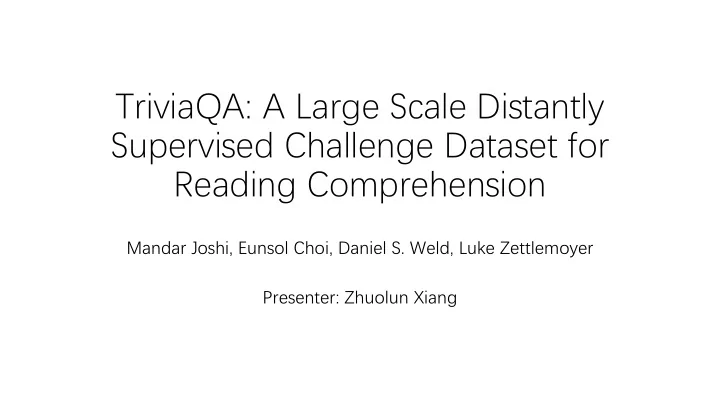

TriviaQA: A Large Scale Distantly Supervised Challenge Dataset for Reading Comprehension Mandar Joshi, Eunsol Choi, Daniel S. Weld, Luke Zettlemoyer Presenter: Zhuolun Xiang
Background • Question Answering (QA) Formulation • Answer a question 𝑟 given evidences 𝐸 • Dataset of tuples 𝑟 𝑗 , 𝑏 𝑗 , 𝐸 𝑗 𝑗 = 1, … , 𝑜} • 𝑏 𝑗 is a substring of D 𝑗 • Example
Overview • TriviaQA • Over 650K question-answer-evidence triples • First dataset where questions authored by trivia enthusiasts • Evidence documents from Web search and Wiki pages • A high percentage of the questions are challenging • Dataset samples
Overview • TriviaQA • Over 650K question-answer-evidence triples • First dataset where questions authored by trivia enthusiasts • Evidence documents from Web search and Wiki pages • A high percentage of the questions are challenging • Dataset samples
Dataset Collection • Gather question-answer pairs from 14 trivia websites • Remove short questions • Collect evidence from Web search and Wikipedia • Web search • Pose questions on Bing • Exclude trivia websites • Crawl top 10 results • Wikipedia • Use TAGME to find Wikipedia entities in the question • Add these pages as evidence
Dataset Collection • Gather question-answer pairs from 14 trivia websites • Remove short questions • Collect evidence from Web search and Wikipedia • Web search • Pose questions on Bing • Exclude trivia websites • Crawl top 10 results • Wikipedia • Use TAGME to find Wikipedia entities in the question • Add these pages as evidence
Dataset Collection • Gather question-answer pairs from 14 trivia websites • Remove short questions • Collect evidence from Web search and Wikipedia • Web search • Pose questions on Bing • Exclude trivia websites • Crawl top 10 results • Wikipedia • Use TAGME to find Wikipedia entities in the question • Add these pages as evidence
Dataset Collection • Gather question-answer pairs from 14 trivia websites • Remove short questions • Collect evidence from Web search and Wikipedia • Web search • Pose questions on Bing • Exclude trivia websites • Crawl top 10 results • Wikipedia • Use TAGME to find Wikipedia entities in the question • Add these pages as evidence
Dataset Analysis • Question-answer pairs • Avg length = 14 • Manually analyze 200 sampled questions Property of questions
Dataset Analysis • Question-answer pairs • Avg length = 14 • Manually analyze 200 sampled questions Property of answers
Dataset Analysis • Question-answer pairs • Avg length = 14 • Manually analyze 200 sampled questions • Evidences • 75.4%/79.7% of Web/Wiki evidences contain answers • Human test achieves 75.3/79.6 accuracy on Web/Wiki domains • Answer 40% of questions needs information from multiple sentences
Experiments: Baseline Methods • Random entity baseline (Wiki domain only) • Entities in Wiki pages form candidate answer set • Randomly pick one that not occur in question • Entity classifier • Ranking problem over candidate answers • Function learnt using LambdaMART (Wu et al., 10) • Neural model • Use BiDAF model (Seo et al., 17)
Experiments • Metrics • Exact match(EM) and F1 score • For numerical and freeform answer: single given answer as ground truth • For Wiki entity: use Wiki aliases as well • Setup • Random partition into train(80%)/development(10%)/test(10%)
Experiments • Results • Human baseline: 79.7% on Wiki, 75.4% on web
Conclusion • TriviaQA • 650K question-answer-evidence triples • Questions authored by trivia enthusiasts • Evidence documents from Web search and Wiki pages • Experiments show TriviaQA is a challenging testbed Thanks!
Recommend
More recommend